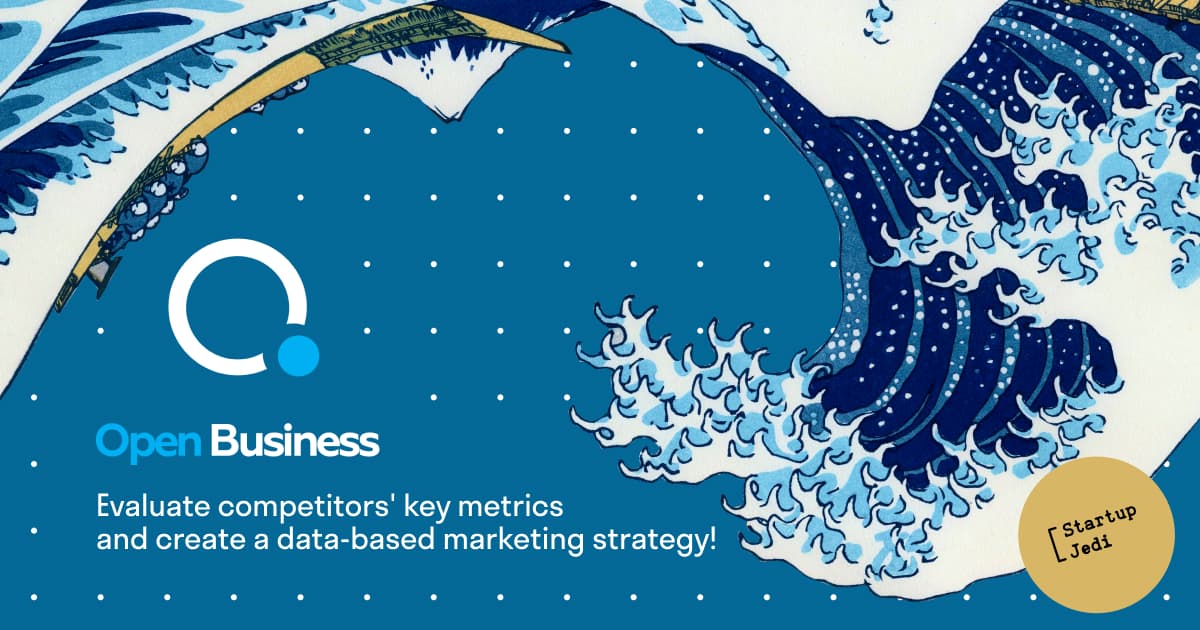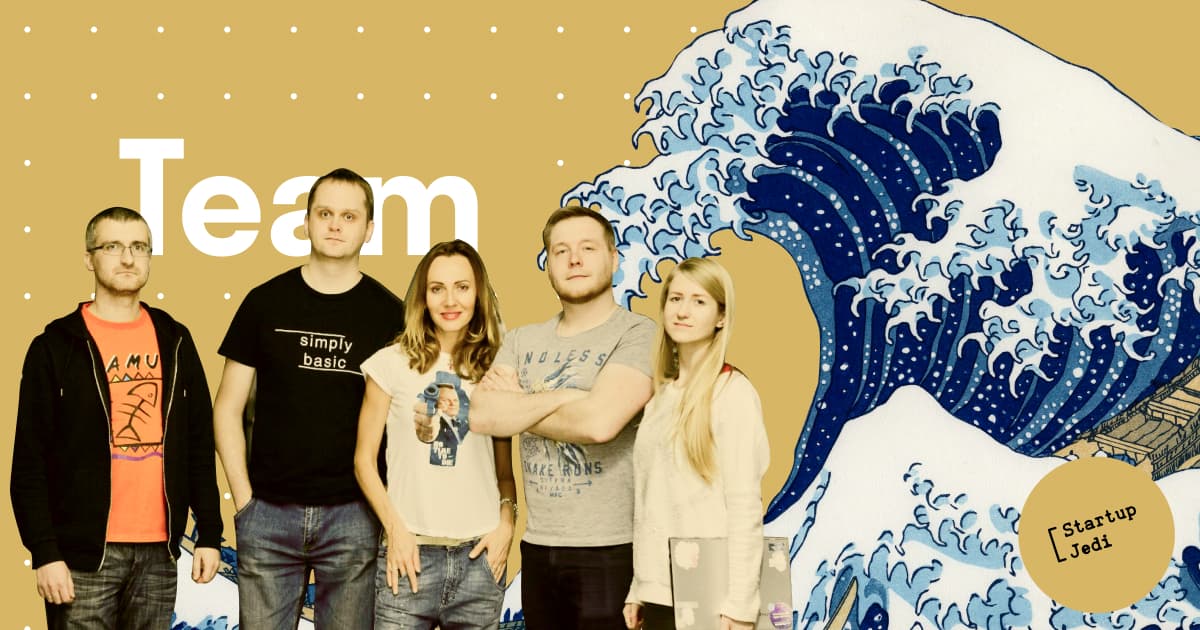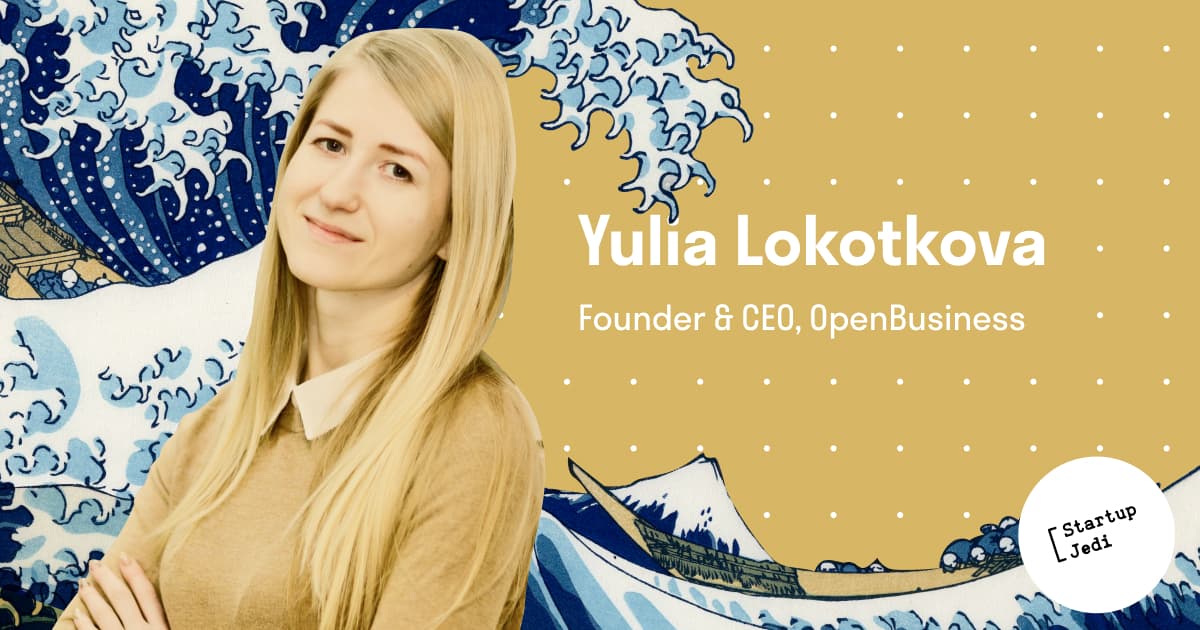
Startup Jedi
We talk to startups and investors, you get the value.
“Tell me what your customers and competitors are buying, and I’ll tell you how to grow your business,” this phrase can describe OpenBusiness, a new startup of Yulia Lokotkova, a well-known financial analyst in Belarusian fintech. This is already her third startup: she has pitched her project to the best business angels and has taken part in the American accelerator Starta Ventures. Investors already estimate OpenBusiness at $2.5M. Yulia shared life hacks on its creation and promotion.

Startup Jedi
We talk to startups and investors, you get the value.
My main business is financial products marketing. Several years ago I realised there was no application on the Belarusian market that would allow me to track consumer finances, and I decided to create one. Besides the classic b2c side of such a product, I was interested in the analytics of customer payment behavior. I can’t say that back then I understood all the perspectives of working with transactional data, but gradually, step by step, this understanding came to me and my team.
The co-founder of the project was a full-stack developer Vitaly Volosyuk whom we met at the hackathon in the summer of 2016, where they made a case for themselves and won the grand prix. It took almost a year to release and in September 2017 PingFin appeared on the Google Market. It’s a financial assistant that automatically takes into account all non-cash income and expenses of the client, analyzes expenses, recommends discounts in cafes, retail chains and banks.
After receiving the first transactional data and talking to retailers, we realized that analytics of the payment behavior of competitors’ customers is in demand on the market. The idea was polished and we created the first prototype of OpenBusiness. At this stage, it became clear that the native application data was insufficient. Firstly, the application could not be released on IOS for technical reasons, which means that part of the audience immediately remained “overboard”. Secondly, Belarusians are not used to budgeting, so the application hardly reached the 50,000 mark downloads at the end of the year.
Considering all these difficulties, the team decided to participate in the American accelerator Starta Ventures (read an interview with Starta here) to launch the application in the US market, where up to 86% of the adult population use personal financial managers (analogs of PingFin).
At the end of 2019, we brought a crazy b2b-b2c hybrid product concept to New York. We expected to launch a cool fintech application and collect a large amount of data that we will use to build analytics for business. However, the accelerator immediately told us that no one would invest in such an unstable concept, since the product should be either b2b or b2c. We were asked to abandon the hybrid and change the product in a month. For OpenBusiness, we took the b2b model and froze b2c. We no longer work with the PingFin project (but it’s alive and continues to help its users).
...

We created PingFin with novice specialists, and we scrupulously recruit people to the OpenBusiness team, paying attention to their experience, competence and motivation.
We’ve gone through fire and water with my co-founder Vitaly Volosyuk. We founded PingFin, we participate in accelerators, and we are the owners of the project. My expertise is marketing, marketing research and public relations of financial companies, as well as networking in this niche. I have over 10 years of experience working with banks and I clearly see where and why I need to come.
Project CTO has worked in large IT-companies with a focus on Fintech and Insurtech-projects for the American market. Project mentor Kirill Voloshin helps with networking.
OpenBusiness was created with an already expanded team and now there are 7 people working on the product. Business Development employs a person with extensive experience in selling analytical products in Big Four companies, its Data Scientist and Backend developer are heads of departments in well-known IT and media companies. We offer options for key employees of the company.
...
The service aggregates anonymized transactions that people make through bank cards and payment services, and builds analytics on their basis for various retail brands and retail facilities. The data comes from data partners: banks, processing centers, neobanks, fintech companies.
By the way, we did not initially plan to launch in Belarus, but in March the coronavirus epidemic began, and the United States closed its borders. The team remained in the country, a legal due diligence was carried out, after which we decided to launch here and we did it in less than six months. Now the startup has 4 partners, and so far there is enough data for work.
The project’s data storage contains more than half a billion transactions and around a million records are added daily. OpenBusiness already covers 15% of the non-cash payment market in Belarus, and this is enough to have a representative sample of data for analytics in almost any retail niche. Thanks to the internal expertise of the team and customer feedback , today it was possible to reduce the extrapolation model error to an average of 3–5% for the brand.

Open Business can work in any market with transactional data. Our goal is to become the largest transaction hub outside Belarus as well. In the future, an open API will allow receiving data from any company with transactional data in any region. We want the process of connecting to our platform to take 2–3 days. There is data in Belarus on which we have tested algorithms, extrapolation, etc., and this will allow us to quickly adapt to the new market.
The service completely changes the approach of business to the analysis of the market and competitors. There is no need to order marketing research, choose a contractor, wait for 3 months, pay tens of thousands of dollars and receive a PDF that most likely won’t give an answer to how a business can generate more money. You can simply go to the platform, select competitors, pay for a subscription and get all the data in a visual and interactive form the same day.
Today, the platform measures 10 key indicators that retailers need: brand turnover, average check, number of transactions, number of unique customers, ratio of loyal audience to new customers, average check, turnover per customer, and also analyzes popular places of customers’ purchases and the sequence of their visits. The service also assesses the audience of different brands in terms of income and expenses, which allows you to correctly build a product line, include more expensive products, if, for example, it turns out that more than 25–30% of the brand’s audience is high spenders.
Our product is suitable both for companies that are experienced in analysis and beginners. To use the platform, you do not need to have a staff of analysts: the owner, the head of marketing or the CFO will understand the key points themselves.
...

The market research market is estimated at $72B in the world, and $41B in the USA. International research companies Ipsos and Nielsen measure the demand for different product groups, which takes a long time. OpenBusiness provides instant analytics on competitors. In other words, if a company claims to have a data-driven strategy, then it does not need to wait several months for a report from Nielsen. If a competitor launched a promotion yesterday, you can see how it changed the payment behavior of users today or tomorrow.
For large companies, our data becomes a real “pain reliever”. One large client of ours jokes that only now his analytics department has begun to work for real. Those companies that managed to become our clients in December 2020 are already using the insights obtained through the platform as the basis for making their management decisions for 2021. OpenBusiness helps growing companies understand market leaders, assess their path to success, and establish effective KPIs for marketing and sales.
It is not yet possible to assess the transactional analytics market, because it is just emerging. In the next five years, according to our forecasts, we will see growth of about 5–7% of the total market.
Our main competitors are employees in the marketing department who do not want the CEO to get an accurate picture of the market. Fortunately, we see less and less of such specialists.
We have one direct competitor in the USA, Second Measure. They work with a small percentage of transactional data from one of the payment systems that is not the leader in the US market. They are tailored to work with investors and provide them with information to assess the investment attractiveness of various companies.
We can already see a much greater potential in OpenBusiness data from analytics for infrastructure projects and developers to the formation of industry standards for projects in the sharing economy. Now the team is delving into customer behavior, changes in transactional activities, trends for retail and is preparing to enter one of the markets close to Belarus.
...

The preliminary assessment of the product by investors is $2.5M. Investments in the project at the Pre-seed stage amounted to $120,000 from the Starta Ventures accelerator, some of which were automatically used to pay for the acceleration program in NYC. Now the project team is focused on sales: the MRR goal is at least $10 in the next 3–4 months.
In the summer and fall of last year, we signed two SAFEs for a small amount, and after that we decided that we wanted to fundraise further, but this time understanding the prospects clearly in terms of sales. Most of the questions have already been answered, we plan to attract a few more business angels so that our “bridge round” is about $100,000 and we can allocate resources for our first steps in another market.
We do not consider all investors: apart from money, the team is interested in expertise and connections in retail.
The main audience of the project is large companies that are ready to pay. All metrics are divided into packages, which include sales, audience analytics, geolocation and historical data (we’ve been receiving data since January 2019). The package price depends on the number of companies. If a company believes that it has three competitors it is one price, if they believe to have 40 we make a personal offer. In Belarus, on average, one company monitors five competitors. You can buy packages for a month, six months or a year. For a large network retailer, the cost is minimal in comparison with their turnover, while the data is truly unique and unquestionable.
If, for example, a coffee shop with one point of sale buys analytics from another similar coffee shop, the entire analytics package will cost up to $99. If a network retailer buys analytics through another network, then the package price starts at $199.
Next, we plan to study how high the analytical culture of medium and small businesses is. One of the goals is to move to automated sales and sell the business as a classic SaaS. By the way, while competitors are doing direct-sales, OpenBusiness is testing the SaaS hypothesis.
...
The team began to contact accelerators in search of a market. Polish state accelerator HugeThink was the first on their list in 2017. It attracts foreign startups to Poland and gives grants without commitment. The PingFin team received €50,000 without giving anything in return. And that was then that we ran into people’s skepticism about applications that want to track finances.
Then there was Starta Ventures, a commercial accelerator from New York, where we could immediately feel the difference between a government and a commercial accelerator. At Starta, they are committed to your growth and success and make every effort to ensure that the startup team does not sit back and do nothing. If it wasn’t for them we would now be much further from the current point of development. There, startups are handled by strong coaches who show from scratch how to communicate with investors, what tools to use. Good fundraising expertise also helps you get in touch with other funds and accelerators. In addition, Starta gave us the expertise in sales and adaptation to the American market. But it should be said that you need to go to such an accelerator with a finished product in order to start selling it, which we did not have at that time.
In the accelerator, we were taught to think in capitalization. I’ll tell you about a common mistake made by Belarusian and Russian startups. They come to you with an offer: “I will give $10,000, what will my share of the company be?” — and the startup starts to “cut” the project. Starta completely changes the paradigm. You need to give back as little as you can since each share is valuable.
Being in the accelerator, our team was able to perform in front of New York Angels (one of the ten most active capital-intensive business angel associations in the world), since the mentor from the accelerator is their member.
We pitched to NYA in February this year, when we had a difficult transition to a b2b product, and the hypothesis had not yet been tested. It was an interesting experience, because we understood what is important for American investors. First, it is imperative to pitch with a clear understanding of the product and user. Secondly, your background and education is important. For example, we were asked how old we were and what colleges we graduated from. And we felt that they wanted Harvard. Our shortlist included teams with participants aged well over 50 with no product, but each had three Phds. The conclusion is that NYA invests in people who are credible. If you are young and ambitious, the MRR should be at least $10,000.
...
The hardest part of our job is getting transactional data, as this is a very vulnerable and delicate topic. It was difficult to get data from one bank and then come to another and ask them for data. This is a new case for Belarus, we are the first to implement it.
Once our СТО Vitaly joked that success will come to us … when the servers will burst with data and no longer cope with the load. Now there is enough data, and we are already solving another problem, namely how to increase the analytical culture of companies.
We need to teach companies how to work with data correctly, make our system significant for the business and at the same time as simple as possible. Ideally, when entering the system, the client will receive recommendations for their segment and their strategy automatically — then our product will sell itself.
...

Focus on what you do. If you want the project to grow and develop, forget about other ideas and startups. In leadership positions, it is impossible to be a member of two startups at the same time. Here’s an insight from the USA: if an American company finds out that you work in several startups, the deal will not go through. People in top positions should be as immersed in the project as possible, and this is true.
Aim at a specific segment. A typical mistake of startups from the CIS is when they say that everyone is their target audience. This is a dead-end road. You cannot invent a user out of your head, based on reviews on the Internet and your own guesses, you need to have a clear portrait of the client, to really dive into it.
Think global. In the US, nobody will say that your product is nonsense. They will say something like “You are probably doing something brilliant, but we do not have expertise in your segment, so try someone else and you will definitely find someone who will instantly sell your product.” Don’t get hung up on one third-party opinion. Research the market and its opportunities as much as possible and concentrate on the best segments.
Go to commercial accelerators whenever possible. There is no need to be afraid or think that your case is local. The investment market is changing a lot today, funds are not running after anyone, so get ready to go all the way through the ecosystem: go to hackathons and accelerators.
Facebook: facebook.com/StartupJedi/
Telegram: t.me/Startup_Jedi
Twitter: twitter.com/startup_jedi
Comments